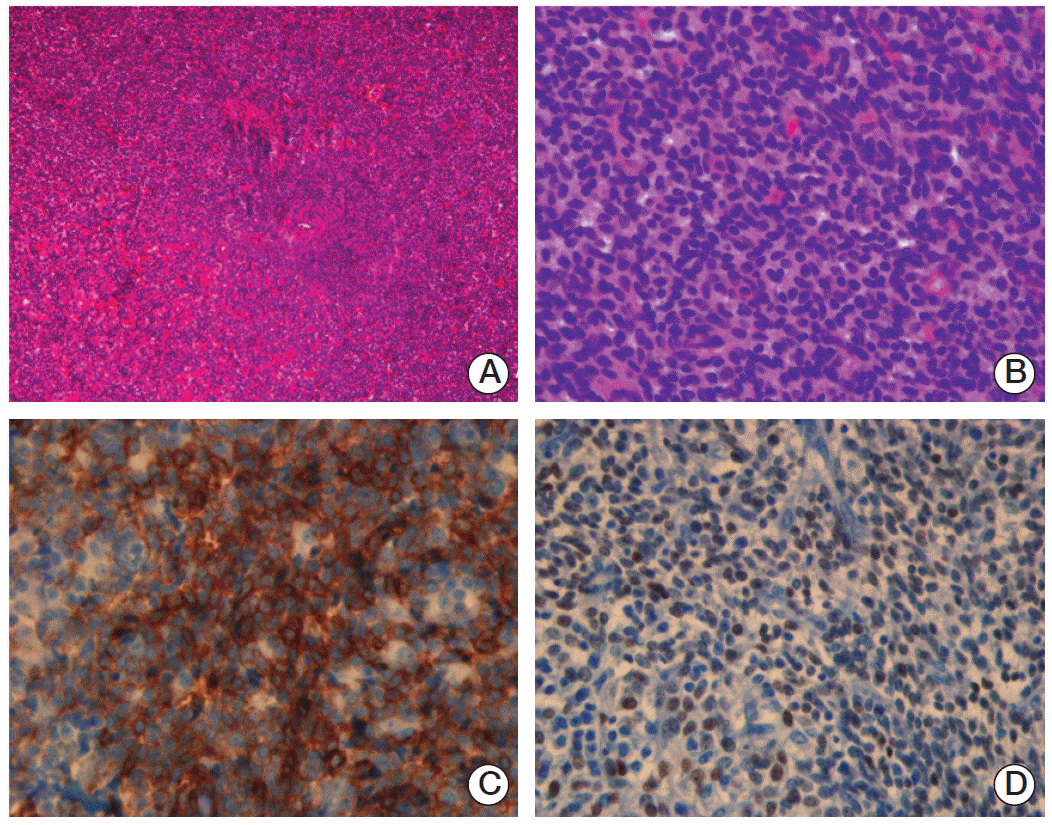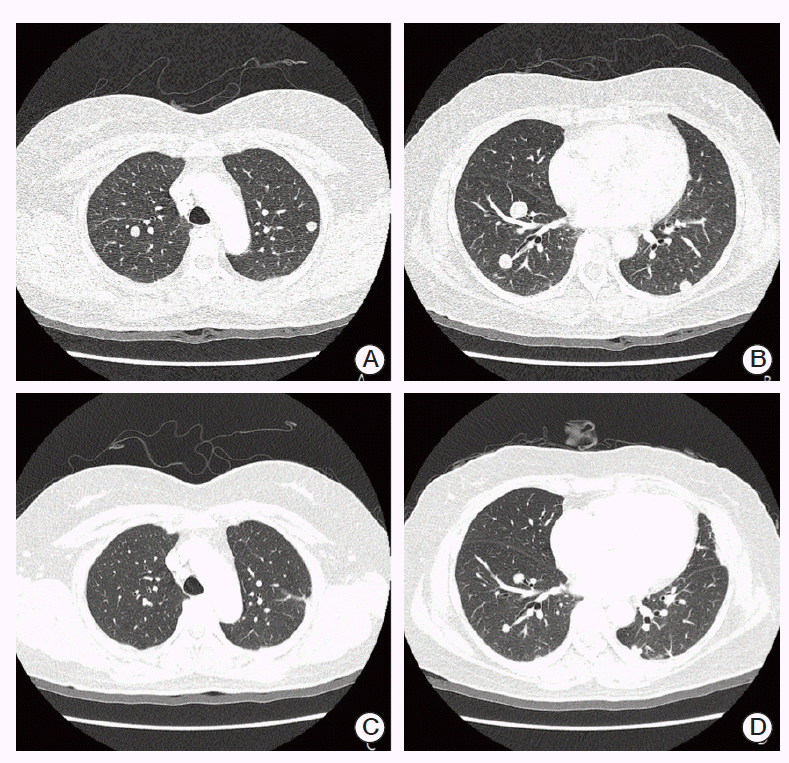Introduction
Endometrial stromal sarcoma (ESS) is a rare uterine mesenchymal neoplasm representing 0.2% or less of all tumors in the genital tract [
1]. According to the tumor cell morphology and mitotic activity, ESS are generally classified as low- or high-grade (less or more than 10 mitoses per 10 high-power fields). These two subtypes, low-grade ESS (LG-ESS) and high-grade ESS (HG-ESS), differ in several biological and histological features [
2]. While LG-ESS takes an indolent clinical course and is associated with a better prognosis than HG-ESS, the risk of recurrence over several years following primary-tumor resection is thought to be as high as 50%. Recurrence is typically locoregional and confined to the pelvis [
3]. In cases of extrapelvic metastasis, the most commonly involved organ is the lung (7%-28% of instances) [
4].
The primary treatment for LG-ESS is hysterectomy. In light of the expression of estrogen receptors (ER) and progesterone receptors (PR), most cases of LG-ESS are thought to be affected by estrogen and progesterone. Still, the antirecurrence efficacy of bilateral salpingo-oophorectomy as an initial treatment is controversial. For recurrent or metastatic LG-ESS, systemic therapy is needed. Several articles have reported on the positive effects of hormonal therapy with megesterol or aromatase inhibitor for patients with metastatic LG-ESS. However, in contrast with breast cancer, there are no guidelines for ovarian ablation in premenopausal women with normally functioning ovaries.
We report herein on the case of a metastatic LG-ESS patient with normally functioning ovaries who was treated effectively with letrozole for 24 months after ovarian ablation by radiotherapy.
Go to :

Case Report
A 50-year-old woman was diagnosed with multiple nodules in both lungs on a chest X-ray as part of a routine medical checkup. The patient, who showed no symptoms, subsequently visited our hospital for a detailed examination. A chest computed tomography (CT) scan confirmed the multiple metastatic nodules in both lungs. Similar findings were observed on a positron emission tomography scan, although we could not find the likely primary focus. We performed a video-assisted thoracoscopic lung biopsy entailing a wedge resection in the left-upper and left-lower lobes. The specimens were well-circumscribed tumors of solid gray-yellow appearance. Under microscopy, the tumors showed perivascular whirling proliferation of ovoid and short spindle cells with scant-to-moderate amounts of eosinophilic cytoplasm and indistinct cell borders (
Fig. 1). On immunohistochemical staining for CD10, ER, and PR, the tumor cells showed a positive reaction (
Fig. 1). On this basis, we diagnosed metastatic LG-ESS.
 | Fig. 1.Microscopic findings on metastatic lung nodules. The tumors show perivascular whirling proliferation of ovoid and short spindle cells with scant-to-moderate amounts of eosinophilic cytoplasm and indistinct cell borders (A, H&E staining, ×100; B, H&E staining, ×400). The tumor cells on immunohistochemical staining for CD 10 (C, ×400), estrogen receptor (D, ×400) and progesterone receptor show a positive reaction. 
|
When queried about her medical history, the patient said that she had undergone a simple hysterectomy via a transabdominal approach 1 year previously. She had initially presented to a gynecology clinic with sudden menorrhagia and dysmenorrhea. Considering those clinical symptoms together with the results of an ultrasound scan, her physician diagnosed uterine myoma. The hysterectomy was then performed, and the subsequent pathology report indicated adenomyosis. However, we reviewed this specimen in the light of our lung biopsy results and concluded that the possibility of ESS with glandular differentiation should be considered.
Because the patient had LG-ESS with multiple lung metastasis, we considered systemic therapy. Given the positive reaction of her tumor cells to staining for ER and PR, we considered that they might be hormone-sensitive. Because she had undergone a simple hysterectomy without oophorectomy, we needed to know her menopausal state. Therefore we tested for serum follicle stimulating hormone (FSH) and estradiol (FSH, 5.9 mIU/mL; estradial, 101.1 pg/mL); based on the results, we diagnosed the premenopausal state. We considered ovarian ablation for removal of the hormonal effect on the tumor cells. We offered the patient two choices: oophorectomy or ovarian ablation by radiotherapy, she opted for the latter. We applied 2,000 cGy of radiation to her ovary 12 times. Fourteen days after this treatment, we retested for FSH and estradiol (FSH, 36 mIU/mL; estradial, 5 pg/mL), and found that she had transitioned to the postmenopausal state.
Two months later, we prescribed letrozole, an aromatase inhibitor (2.5 mg once per day). Three months following the commencement of this medication, she underwent a chest CT scan, which indicated that the metastatic nodules in both lungs had decreased in size (9.5 mm to 3.4 mm, 16.6 mm to 11.1 mm, 11.2 mm to 7 mm) (
Fig. 2). We subsequently repeated the chest CT scan every 3 months. A scan performed 24 months after the initial therapy showed that the residual metastatic nodules in both lungs remained in partial remission.
 | Fig. 2.(A, B) Initial chest computed tomography scans showing multiple metastatic nodules in both lungs. (C, D) The patient was treated with letrozole, and, 3 months later, the size of the metastatic nodules in both lungs had decreased, indicating a partial response. 
|
Go to :

Discussion
Total abdominal hysterectomy is the standard treatment for nonmetastatic LG-ESS. In the case of stage I-II LG-ESS, the merits of concurrent bilateral salphingo-oophorectomy remain controversial. Li et al. [
5] reported that the recurrence rate of LG-ESS in patients who underwent bilateral oophorectomy was significantly lower than that in patients with normal ovarian function. In fact, Gadducci et al. [
6] stressed that bilateral salpingo-oophorectomy should be considered mandatory for patients with LG-ESS. However, some authors have argued that in the case of early-stage disease, the recurrence rate of patients with retained ovaries might not show a significant increase [
7,
8]. As contraindicative of elective oophorectomy, in many patients with LG-ESS the initial diagnosis is often myoma or adenomyosis; as a resultant, they not infrequently undergo simple hysterectomy without bilateral oophorectomy, as in the case of our patient. Pink et al. [
9] reported that a LG-ESS diagnosis was established by hysterectomy in six of ten patients. As for our patient, who had undergone a simple hysterectomy without bilateral salphingo-oophorectomy due to misdiagnosis of adenomyosis, it was not clear whether the retained ovaries resulted in the recurrence.
As reflected by the acute rarity of this tumor, no randomized, controlled clinical trials for treatment of recurrent or metastatic LG-ESS have been conducted, and there are only several case reports on effective treatments. As in breast cancer, LG-ESS usually expresses ER and PR; accordingly, hormone receptor–targeted treatment should be considered. By contrast with the previously reported cases, our patient still had her ovaries when her multiple lung metastasis was detected. This is why we confirmed the premenopausal state with normal ovarian function according to the FSH and estradiol levels. As in hormone receptor–positive breast cancer, ovarian ablation by surgical procedure or irradiation might be necesssary in patients with ER- and PR-positive LG-ESS. As already noted, our patient underwent ovarian ablation by irradiation.
As noted earlier, patients with LG-ESS not infrequently undergo simple hysterectomy without oophorectomy. In fact, the previous reports have not commented on the issue of retained ovaries in cases of recurrence, and we think that there are two reasons. First, with respect to recurrence in the pelvic cavity, which accounts for more than 50% of all recurrences, patients generally undergo resection with concurrent oophorectomy. Second, because LG-ESS is a slow-growing tumor, the patient usually has attained the postmenopausal state by the time of distant metastasis.
This would explain the lack of reports on management of retained ovaries in cases of LG-ESS. Nevertheless, we believe that functional or anatomical ovarian removal is necessary in cases of hormone-sensitive LG-ESS, in the same sense as medical or surgical oophorectomy is necessary in cases of premenopausal women with hormone-sensitive breast cancer. This notwithstanding, there are no reports (besides the current one) on ovarian ablation; in addition, we concede that the efficacy of ovarian ablation remains in doubt. This is a limitation of our report.
After removal of ovaries, the synthetic derivative of progesterone, megesterol or aromatase inhibitor is considered first for the systemic treatment of metastatic LG-ESS. The potential benefit of progestin therapy in patients with LG-ESS is based on the fact that the morphological and endocrinological similarities between LG-ESS and endometrial stromal cells and progestins can cause inhibition of the proliferation of normal endometrial epithelium. One of the earliest reports of successful treatment of recurrent disease by progestin is that of Pellillo in 1968 [
10]. Several case reports on LG-ESS followed, all of which showed successful outcomes of progestin therapy [
7,
9,
11]. Chu et al. [
7] reported that seven of eight patients treated with megesterol for recurrent disease showed either stable disease (3/8, 38%) or complete remission (4/8, 50%).
Aromatase is the enzyme responsible for estrogen biosynthesis, specifically by conversion of androstenedione and testosterone (secreted by adrenal glands in peripheral tissues) to estrone and estradiol. Letrozole is an orally administered, selective, nonsteroidal triazole derivative that potently inhibits aromatase without interfering with the steroid and progesterone pathways. For these reasons, letrozole is used for postmenopausal women with advanced or metastatic breast cancer. Maluf et al. [
12] first reported in 2001 on an LG-ESS patient who had been treated with megesterol who showed a partial response to a daily dose of 2.5 mg of letrozole over the course of 9 months. In 2011, Shoji et al. [
13] reported, correspondingly, that a recurrent LG-ESS patient treated with anastrozole achieved a 9-month partial response.
In prospective trials on breast cancer [
14], aromatase inhibitor has shown better results than megesterol; unfortunately, comparison of these two drugs for LG-ESS is difficult. In a retrospective analysis by Pink et al. [
9], two of four patients treated with megesterol derived no benefit at any point in time; contrastingly, therapy with letrozole was initially effective in four of five patients as well as in one patient in whom megesterol therapy had failed. According to these reported results, we first tested letrozole, not megesterol. In contrast with breast cancer, the selective ER-modulator tamoxifen is contraindicated in the treatment of LG-ESS as it has an agonistic activity on endometrial stromal cells in endometriosis and residual ESS [
15].
Despite reports of use of doxorubicin-ifosfamide-based chemotherapy for metastatic ESS [
4,
9], most cases were high-grade ESS, thus, the results cannot be easily applied to LG-ESS. And, in particular, as hormonal therapy has shown superior responses and lower incidences of toxicity in previous reports, substitution of systemic chemotherapy for hormonal therapy is thought to be of dubious value. Nonetheless, it remains a possible alternative option for salvaging of treatment in hormone-refractory cases [
9].
This is the first report on the long-term use of letrozole for metastatic LG-ESS after ovarian ablation by radiotherapy. Further studies evaluating the effectiveness of removal of ovarian function by oophorectomy or irradiation are necessary. In addition, a prospective trial on letrozole or megesterol with advanced LG-ESS patients is warranted.
Go to :






 PDF
PDF Citation
Citation Print
Print



 XML Download
XML Download